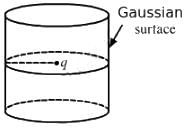Short Answers
Q.1. A small plane area is rotated in an electric field. In which orientation of the area, is the flux of the electric field through the area maximum? In which orientation is it zero?
The flux of an electric field  through a surface area
through a surface area  is given by Δ Ø =
is given by Δ Ø =  where ΔØ is the flux . Therefore , ΔØ= E Δ S Cos θ .
where ΔØ is the flux . Therefore , ΔØ= E Δ S Cos θ .
Here , θ is the angle between the electric field  and the normal to the surface area.
and the normal to the surface area.
Thus, for the flux to be maximum, cos θ should be maximum. Thus, for θ = 0, the flux is maximum, i.e. the electric field lines are perpendicular to the surface area.
The flux is minimum if θ = 90. Thus, cos θ = 0 and, hence, flux is also 0. Thus, if the electric field lines are parallel to the surface area, the flux is minimum.
Q.2. A circular ring of radius r made of a non-conducting material is placed with its axis parallel to a uniform electric field. The ring is rotated about a diameter through 180°. Does the flux of the electric field change? If yes, does it decrease or increase?
It is given that the circular ring, made of a non-conducting material, of radius r is placed with its axis parallel to a uniform electric field.This means that both the electric field and the area vector are parallel to each other (area vector is always perpendicular to the surface area). Thus, the flux through the ring is given by 
Now, when the ring is rotated about its diameter through 1800, the angle between the area vector and the electric field becomes 1800. Thus, the flux becomes 
Q.3. A charge Q is uniformly distributed on a spherical shell. What is the field at the centre of the shell? If a point charge is brought close to the shell, will the field at the centre change? Does your answer depend on whether the shell is conducting or non-conducting?
The field at the centre of the shell is zero. As all the charge given to a conductor resides on the surface, the field at any point inside the conducting sphere is zero. Also, the charge distribution at the surface is uniform; so all the electric field vectors due to these charges at the centre are equal and opposite. So, they cancel each other, resulting in a zero net value of the field.
When a charge is brought near the shell, due to induction, opposite polarity charges induce on the surface nearer to the charge and the same polarity charges appear on the face farther from the charge. In this way, a field is generated inside the shell. Hence, the field at the centre is non-zero.
Yes, our answer changes in case of a non-conducting spherical shell. As the charge given to the surface of a non-conducting spherical shell spreads non-uniformly, there is a net electric field at the centre of the sphere.
Q.4. A spherical shell made of plastic, contains a charge Q distributed uniformly over its surface. What is the electric field inside the shell? If the shell is hammered to deshape it, without altering the charge, will the field inside be changed? What happens if the shell is made of a metal?
As the shell is made of plastic, it is non-conducting. But as the charge is distributed uniformly over the surface of the shell, the sum of all the electric field vectors at the centre due to this kind of distribution is zero. But when the plastic shell is deformed, the distribution of charge on it becomes non-uniform. In other words, the sum of all the electric field vectors is non-zero now or the electric field exists at the centre now.
In case of a deformed conductor, the field inside is always zero.
Q.5. A point charge q is placed in a cavity in a metal block. If a charge Q is brought outside the metal, will the charge q feel an electric fore?
Yes, the charge Q will feel an electric force, as the charge q given to the metal block appears on the surface. Hence, it exerts an electric force on the charge Q.
Q.6. A rubber balloon is given a charge Q distributed uniformly over its surface. Is the field inside the balloon zero everywhere if the balloon does not have a spherical surface?
No, the field is not zero everywhere, as the electric field vector due to the charge distribution does not cancel out at any place inside the balloon because of its non-spherical shape.
Q.7. It is said that any charge given to a conductor comes to its surface. Should all the protons come to the surface? Should all the electrons come to the surface? Should all the free electrons come to the surface?
Protons never take part in any electrical phenomena because they are inside the nuclei and are not able to interact easily. These are the free electrons that are responsible for all electrical phenomena. So, if a conductor is given a negative charge, the free electrons come to the surface of the conductor. If the conductor is given a positive charge, electrons move away from the surface and leave a positive charge on the surface of the conductor.
Multiple Choice Questions
Question for HC Verma Questions and Solutions: Chapter 30: Gauss’s Law- 1
Try yourself:A charge Q is uniformly distributed over a large plastic plate. The electric field at a point P close to the centre of the plate is 10 V m−1. If the plastic plate is replaced by a copper plate of the same geometrical dimensions and carrying the same charge Q, the electric field at the point P will become
Explanation
The electric field remains same for the plastic plate and the copper plate, as both are considered to be infinite plane sheets. So, it does not matter whether the plate is conducting or non-conducting.
The electric field due to both the plates,

Report a problem
Question for HC Verma Questions and Solutions: Chapter 30: Gauss’s Law- 1
Try yourself:A metallic particle with no net charge is placed near a finite metal plate carrying a positive charge. The electric force on the particle will be
Explanation
The particle is a conductor. When it is brought near a positively charged metal plate, opposite charge is induced on its face nearer to the plate, i.e. negative and the same amount of charge, but of opposite polarity, goes to the farther end, i.e. positive.
Now, the attractive force is due to charges of opposite polarity. As they are at a lesser distance than the same polarity charges, the force of attraction is greater than the force of repulsion. In other words, the force on the particle is towards the plate.
Report a problem
Question for HC Verma Questions and Solutions: Chapter 30: Gauss’s Law- 1
Try yourself:A thin, metallic spherical shell contains a charge Q on it. A point charge q is placed at the centre of the shell and another charge q1 is placed outside it as shown in the following figure . All the three charges are positive. The force on the charge at the centre is ____________.
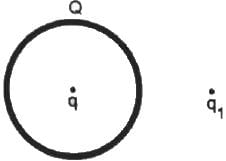
Explanation
A charge placed outside a conductor can induce a charge on it or can affect the charge on its surface. But it does not affect what is contained inside the conductor. Similarly, charge q1 can affect charge Q; still, the force inside the conductor remains zero. An analogy to the above statement is that when lightning strikes a car, the charge that appears on the car's metal surface does not affect its interior. Due to this passengers are recommended to sit inside the car.
Report a problem
Question for HC Verma Questions and Solutions: Chapter 30: Gauss’s Law- 1
Try yourself:A thin, metallic spherical shell contains a charge Q on it. A point charge q is placed at the centre of the shell and another charge q1 is placed outside it as shown in the following figure . All the three charges are positive. The force on the central charge due to the shell is
Explanation
This question can be answered using the concept of electric field lines.
We know that electric field lines emerge from a positive charge and move towards a negative charge. Now, charge Q, on the face in front of charge q1, tries to nullify the field lines emerging from charge q1. So, the charge on the farther face of the conductor dominates and, hence, a force appears to the right of charge q.
Report a problem
Question for HC Verma Questions and Solutions: Chapter 30: Gauss’s Law- 1
Try yourself:Electric charges are distributed in a small volume. The flux of the electric field through a spherical surface of radius 10 cm surrounding the total charge is 25 V m. The flux over a concentric sphere of radius 20 cm will be ______.
Explanation
The flux through a surface does not depend on its shape and size; it only depends upon the charge enclosed inside the volume. Here, the charge enclosed by the sphere of radius 10 cm and the sphere of radius 20 cm is same so the flux through them will also be same.
Report a problem
Question for HC Verma Questions and Solutions: Chapter 30: Gauss’s Law- 1
Try yourself:Following Figure (a) shows an imaginary cube of edge L/2. A uniformly charged rod of length (L) moves towards the left at a small but constant speed v. At t = 0, the left end just touches the centre of the face of the cube opposite it. Which of the graphs shown in the figure (b) represents the flux of the electric field through the cube as the rod goes through it?
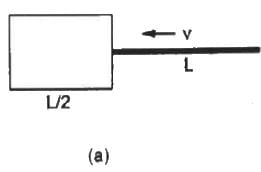

Explanation
At first, when the rod is inserted into the cube, the flux start increasing. When the rod is fully inserted, the flux becomes constant and remains constant for the remaining L/2 length of the rod. After that, as the rod moves out of the cube, the flux starts decreasing. These processes are depicted only by curve (d).
Report a problem
Question for HC Verma Questions and Solutions: Chapter 30: Gauss’s Law- 1
Try yourself:A charge q is placed at the centre of the open end of a cylindrical vessel (see the figure). The flux of the electric field through the surface of the vessel is _______.

Explanation
Report a problem
Question for HC Verma Questions and Solutions: Chapter 30: Gauss’s Law- 1
Try yourself:Mark the correct options:
Explanation
The contribution of flux on the closed surface due to the charges lying outside the surface is zero because number of field line entering the closed surface is equal to the number of field lines coming out of the surface so the net contribution of the charge lying outside the closed surface to the flux is zero. Therefore, the net flux through the surface due to the charge lying outside the the closed surface is zero. The contribution that counts is only due to the charges lying within the closed surface.
Thus, the flux of the electric field through a closed surface due to all the charges (inside and outside the surface) is equal to the flux due to the charges enclosed by the surface.
Report a problem
Question for HC Verma Questions and Solutions: Chapter 30: Gauss’s Law- 1
Try yourself:A positive point charge Q is brought near an isolated metal cube.
Explanation
Since the cube is metallic, the charge gets distributed on the surface and the interior remains charge-free. However, when a positive point charge Q is brought near the metallic cube, a negative charge gets induced on the face near the positive charge Q and an equal positive charge gets induced on the face, which is away from the charge Q. Thus, the metallic surface gets non-uniform charge distribution.
Report a problem
*Multiple options can be correct
Question for HC Verma Questions and Solutions: Chapter 30: Gauss’s Law- 1
Try yourself:A large non-conducting sheet M is given a uniform charge density. Two uncharged small metal rods A and B are placed near the sheet as shown in the following figure.
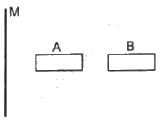
Explanation
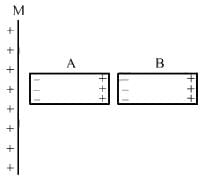
Since the non-conducting sheet M is given a uniform charge, it induces a charge in the metal rod A, which further induces a charge in the metal rod B, as shown in the figure. Hence, all the options are correct.
*Multiple options can be correct
Question for HC Verma Questions and Solutions: Chapter 30: Gauss’s Law- 1
Try yourself:If the flux of the electric field through a closed surface is zero,
Explanation
As the flux is zero through the surface, the charge enclosed must be zero. But the electric field is not necessarily zero everywhere on the surface. For example, in the case of a dipole enclosed by the surface, the electric field through the surface is not zero but has some value. So, the correct answers are (b) and (c).
*Multiple options can be correct
Question for HC Verma Questions and Solutions: Chapter 30: Gauss’s Law- 1
Try yourself:An electric dipole is placed at the centre of a sphere. Mark the correct options.
Explanation
The sphere encloses a dipole, i.e. two equal and opposite charges. In other words, net charge enclosed in the sphere is zero. Hence, the flux is zero through the sphere.
But the electric field at any point p on the sphere,

where θ is the angle made by the point p with the centre of the dipole.
Hence, we can see that the field is not zero anywhere on the sphere.
*Multiple options can be correct
Question for HC Verma Questions and Solutions: Chapter 30: Gauss’s Law- 1
Try yourself:In the following figure shows a charge q placed at the centre of a hemisphere. A second charge Q is placed at one of the positions A, B, C and D. In which position(s) of this second charge, the flux of the electric field through the hemisphere remains unchanged?

Explanation
These are the only points in the straight line with the charge q and at the brim of the hemisphere. So, field lines emerging from these charges do not affect the flux through the hemisphere due to charge q. On the other hand, the two remaining charges are beside the surface of the hemisphere and not in line with the charge q and not at the brim. So, they will affect the flux. Hence, the correct answers are (a) and (c).
*Multiple options can be correct
Question for HC Verma Questions and Solutions: Chapter 30: Gauss’s Law- 1
Try yourself:A closed surface S is constructed around a conducting wire connected to a battery and a switch in the following figure. As the switch is closed, the free electrons in the wire start moving along the wire. In any time interval, the number of electrons entering the closed surface S is equal to the number of electrons leaving it. On closing the switch, the flux of the electric field through the closed surface
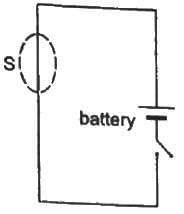
Explanation
Initially, there is no charge in the closed surface. As the wire is neutral, the flux initially is zero. Now, if we connect the battery and a current flows through it, the flux remains zero, as the number of electrons entering the surface is equal to number of electrons leaving. That is, net charge enclosed is zero and so is the flux.
Question for HC Verma Questions and Solutions: Chapter 30: Gauss’s Law- 1
Try yourself:The following figure shows a closed surface that intersects a conducting sphere. If a positive charge is placed at point P, the flux of the electric field through the closed surface

Explanation
A positive charge at point P will induce a negative charge on the near face of the conducting sphere, whereas the positive charge on the farther end of the sphere. As this father end is enclosed or intersected by the closed surface, so the flux through it will become positive due to the induced positive charge.
Report a problem
through a surface area
is given by Δ Ø =
where ΔØ is the flux . Therefore , ΔØ= E Δ S Cos θ .
and the normal to the surface area.

















